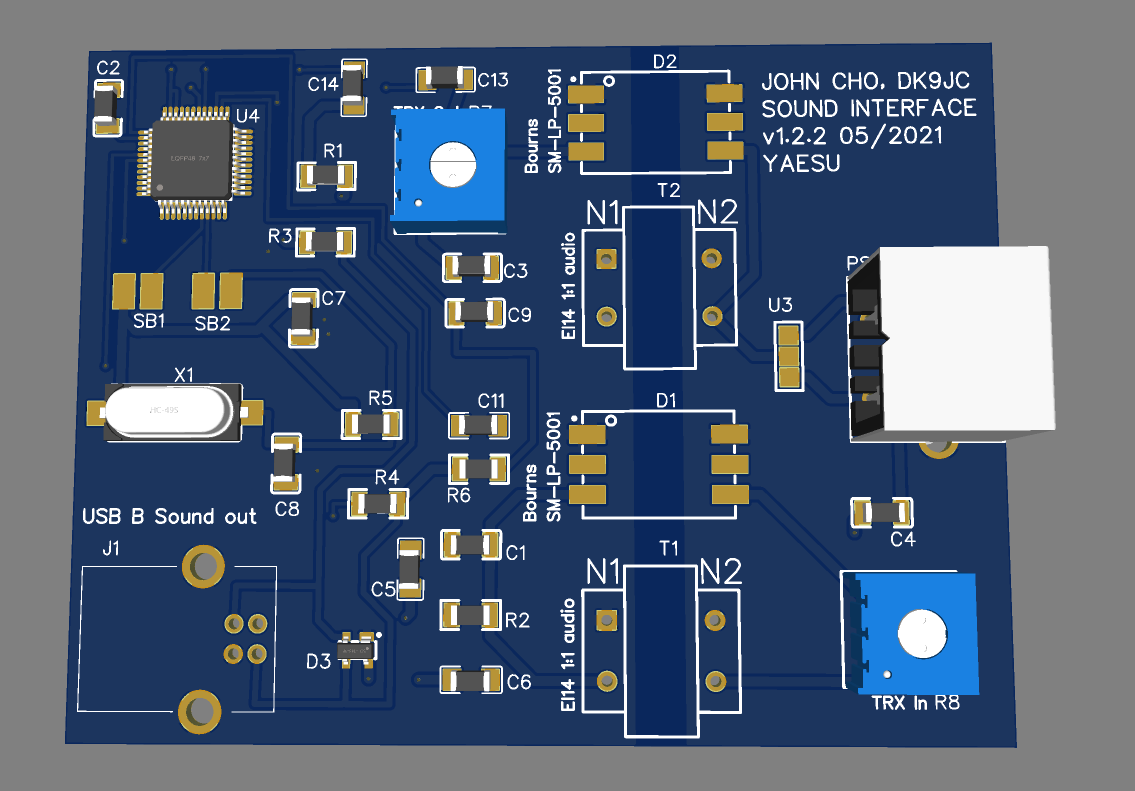Some time ago I already built some "loose" interfaces for my FT-817. I used these later on my FT-891. The CAT, respectively the FTDI USB to serial converter I needed at the FT-8x7, I don't need at the FT-891 anymore, because it already has CAT via USB integrated. The FT-891 simply uses a Silicon Labs CP2105-F01 USB/Serial UART converter internally. As with many other TRXs, this is not galvanically isolated, but the engineers thought of something. Apparently it works well anyway. I have had no problems at least in the last 2 years.
The problem with my Yaesu FT-891:
Contrary to the first press reports from late 2016, the FT-891 did not have a sound card built in after all. For a current transceiver, that's pretty sad. Either the 2 chips (USB hub and sound card) were too expensive or the space was not enough.
Good soloution on the FT-991(A)
In the FT-991(A) first a Microchip USB hub 2512BI distributes the signal to the Silicon Labs CP2105-F01 USB/Serial UART converter for CAT and also to the sound card Texas Instruments TI PCM2903BDB. A and non-A versions uses the same parts.

IC-7300:
Icom has as well implemented this on the IC-7300 actually quite well. After the USB-B there is a USB Hub (TUSB2046BIVFR), then a serial "Cat-Converter" (CP2102GMR) and the sound card, called "Sound CODEC" (Texas Instruments TI PCM2901E). There is then even one USB output free on the hub chip. Those TI chips are not that cheap, so I looked for another option.
My approach:
I would like to have such a simple solution with the sound card also in the FT-891. Directly when I bought the FT-891, I built a galvanically isolated sound interface on a breadboard. So far it works perfectly and I used it for many portables out in the field on the laptop or also on the Raspberri Pi for WSJT-X modes like FT8 and FT4.
Somehow I just didn't like the loose design anymore. So I wanted to design a prototype. Sometime one evening I quickly drew a version and ordered 10 PCBs. That same night I came up with some more ideas. I also didn't want to use an external USB soundcard anymore, but wanted to have a soundchip directly on the PCB. For this I had to read some datasheets. Finally I decided to use the CM108AH and CM108B from Taiwan. The costs are about 1/3 of the TI chips with on paper comparable performance.

Since the FT-891 also has an extremely well performing data vox, you can even do digimodes without CAT (which only requires a USB-A to USB-B cable). But most of the time I have the cable with me, especially to read and log the frequencies automatically or also to switch the band.
So my requirements were:
- Galvanic isolation of PC/Raspberri Pi and the TRX side.
- Wide isolation gap between the two GND potentials
- Large groundplanes for GND and GND2 on both PCB sides
- no CAT (already implemented in FT-891 via USB + additional Audio Vox)
- both in and out levels adjustable via 1k potentiometer
- 1200bd/9600bd changeable via jumper
- USB-B connector, so you can also use the CAT cable in case of need (audio vox still works then)
- 6-pin mini DIN connector, so that a 1:1 cable can be used directly
- Of course, any other TRX can be used, if you adapt the cable.
Other considerations:
With CM108 the version AH is apparently everywhere standard. But here, besides the chip, 4 additional components (12 MHz quartz, 2 x C, 1 x R) are required. The version B gets along without these components. So I have provided the PCB for both versions. If SB1 and SB2 are open, you can use CM108B without quartz. If SB1/SB2 are soldered, i.e. closed, you can use CM108AH. The quartz is then "active".
Useful ressources:
By the way, via Google (CM108+Interface) I found Denis, K0TX with his very nice digirig project. He really has many interesting approaches and has already developed different versions of his interface for home and in the field. He is a very nice guy and answered all my questions willingly. I would also like to thank F1ULQ for his feedback on my PCB layout and for his tips. DL1MY has also built something nice. However, it was probably more about CAT (like the name indicates). Sadly there is no sound card implemented, only analog outputs for an external USB sound card or the sound card in the PC. Still, I think it's extremely well done. Article in German language on CQ-Jena.
